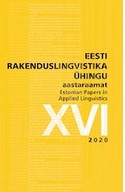EESTI TEMPERATUURIADJEKTIIVIDE POLÜSEEMIAMALLID
SYSTEMIC POLYSEMY PATTERNS OF ESTONIAN TEMPERATURE ADJECTIVES
Author(s): Maria TuulikSubject(s): Theoretical Linguistics, Lexis, Semantics, Finno-Ugrian studies, Phraseology
Published by: Eesti Rakenduslingvistika Ühing (ERÜ)
Keywords: semantic types; polysemy; lexicography; lexicology; semantics; corpus linguistics; Estonian;
Summary/Abstract: The article gives an overview of temperature adjectives in Estonian and ascertains the regularities of their semantic structure. Patterns of systematic polysemy of temperature adjectives are identified, for the purpose of providing a theoretical framework for lexicographical work. The corpus data used in the article originates from Estonian National Corpus 2017 (ENC17). For corpus analysis Sketch Engine’s (Kigarriff et al. 2014) word sketch, distributive thesaurus, and word lists functions are used. To find the patterns, semantic types were added to meanings and similarities were searched among meaning shifts. The tagging of adjective meanings is based on the semantic types developed to describe Estonian (polysemous) adjectives (Tuulik 2014) and the typology has been further developed according to the semantics of temperature words. The semantic types are planned to be added to the new database of the Institute of the Estonian Language, Ekilex (Koppel et al. 2019), in order to allow for more precise search by lexicographers and researchers. As a result of the analysis of the temperature words, 10 polysemous patterns emerged. The article discusses the potential motivation and lexicographic presentation of the more frequent patterns. Consistent presentation of patterns in a dictionary or database may not be an end in itself, as the presentation of meanings is influenced by many factors (target users’ needs, word frequency, meaning frequency, etc.), but taking patterns into account ensures that inclusion or exclusion of the meaning is a conscious decision.
Journal: Eesti Rakenduslingvistika Ühingu aastaraamat
- Issue Year: 2020
- Issue No: 16
- Page Range: 223-240
- Page Count: 18
- Language: Estonian

